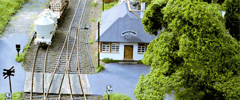Invitation
The meeting organiser names in the invitation for a meeting:
- Time/ place (including begin of the assembling) and location of the meeting
- Theme of the layout (era, operation mode, etc.)
- Information about accommodation and catering
- Deadline for registration
Registration
Until the deadline, interested party can register to the meeting organiser. They offer thereby, what they can contribute to the layout:
- Modules (with draft or CAD-drawing) and station's data sheets
- Locomotives (type, number, DCC address)
- Cars (at least number of cars per type, if possible car numbers)
- DCC equipment (command stations, booster, free usable Loconet equipment)
- Telephone system / telephones
- Clock-pulse generator / secondary clocks
On the registration the participant announced, from and to (assembling and disassembling!) he will be present.
Organization
Depending on the size of the meeting the meeting organiser gets or names assistants:
- Layout designer
- Timetable creator
The layout designer, timetable creator and meeting organiser decide, with consideration of theme's and operation's guidelines, as well as the location's circumstances, which modules can be used. Furthermore, they check, on the basis of the registered equipment (clocks, telephones, DCC, etc.), whether the layout can be operate suchlike.
Layout designer and meeting organiser publish the assembling plan at an early stage and at the same time, and announced the beginning of the assembling. Furthermore, they inform participants, if offered modules are not planned to use, in order to spare space of transportation. The timetable creator creates the train graph, using the information about the requested amount of traffic of the involved stations, the layout plan, as well as the registered stock of vehicles, on that, after consultation with all involved station's owners, the timetable books, regulations for marshalling etc. will be generated.
The meeting organiser sees to accommodations, soft drinks, catering, lectures, excursions etc. Furthermore, he names someone, who takes care of the issues:
- Clocks
- Telephone
- DCC command stations
Assembling
All module's owners see to it that their modules are placed according to the assembling plan, and are connected mechanically and electrically to its neighbour modules, in order to provide a smooth assembling. Furthermore, they install – as far as intended in the plan – Loconet and, if necessary, booster at their modules; they advise the DCC assistant to inbuilt Loconet-jacks. At last all tracks are cleaned. Contact person for questions is the layout designer.
The DCC assistant checks the Loconet (also, whether all inbuilt Loconet-jacks are connected), installs the DCC center, takes it in service operation, checks the polarity of the booster sections and sees to test runs. If there is enough equipment at hand, it is recommended to install a secondary DCC center including a programming track for test runs and programming of locomotives.
The clock assistant installs the clock-pulse generator and the clocks, connect them, and sees to it that all clocks run synchronously. He adjust the clocks to the start time (information from the timetable creator).
The telephone assistant takes the telephone devices in service operation and distributes telephone directories to all stations.
The timetable creator distributes timetable documents to the station's owners, which are to be installed clearly visible. Furthermore, he ensure that a basic arrangement of cars is made.
The station's owner put freight requests and, if necessary, goods at senders and fiddle yards.
At last a recommendation: The FREMO name tag should be worn from the beginning. It makes communication easier – last but not least with non-members – and serves as a passport.


